
‘Underwater,’ ‘overwhelmed’: Doctors presentation paints dire picture of Sask. health care
On Thursday, the Saskatchewan government announced a loosening of the isolation rules around COVID-19 while talking about learning to live with the virus.
Just a few hours later, doctors in the province listened to a presentation that painted a much more grim picture.
Every other week, leaders in the Saskatchewan Health Authority (SHA) put together a presentation with information for doctors about where the authority is at and what it’s doing in the pandemic, and often with technical or workplace information doctors might need.
Much of the presentation on Thursday centred around the current load within Saskatchewan health care, and the anticipated increase.


